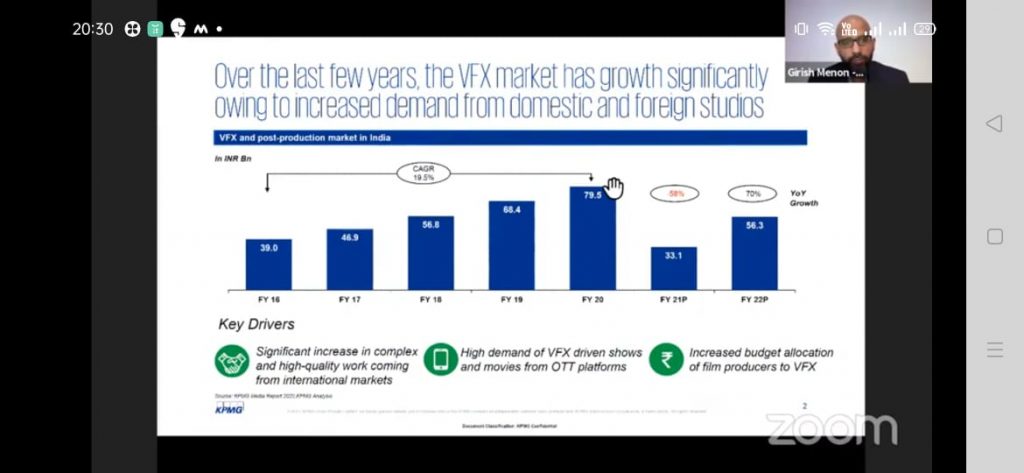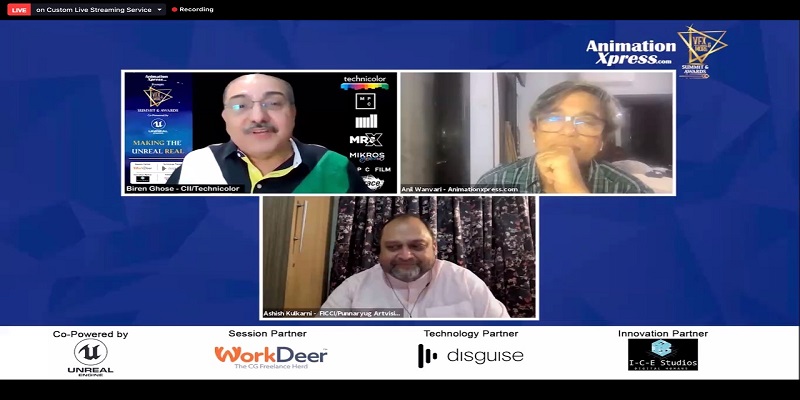
The year 2020 has taught us how we can sustain while staying at home. Earlier, Indian VFX studios which did not practice remote working apart from providing services to international clients has certainly scaled up to shift their workspace at home overnight. This major shift has helped the sector vastly in 2020. The VAM Summit, organised by AnimationXpress, witnessed an array of eminent speakers sharing their stories and industry updates.
Similarly KPMG partner and head – M&E Girish Menon shared an exclusive presentation to discuss on the past, present, future of the VFX industry. Menon shared that Covid-19 had a tough impact on the VFX segment, particularly when the content production had stopped. Even today the supply chains and pipelines are still slow despite the commencement of the production.
According to him, VFX will take a little bit longer time to recover as the supply got constrained. “What this lockdown and disruption has taught us is that we cannot depend on geographies and existing processes so there is going to be much more collaboration throughout the world,” he added.
There was a range of challenges when shifting to a remote workflow for both the VFX studios and the artists due to Covid-19. Here are the impacts and long term trends in the sector
- Leaner cost structure in the long term: Shift to a work from home model with a lower proportion of employees being asked to work from office locations, likely to save infrastructure costs.
- Increased focus on virtual production: The new normal for foreign and domestic production houses is to resort to chroma shooting and previsualisation going forward to aid the production and planning process across genres.
- Renegotiation of commercial terms of VFX projects in the long run on account of higher scope of work for VFX studios and increased dependency on them.
- Global collaboration: With a higher number of VFX companies focusing on a global production model, new avenues of global collaboration are likely to open up for the Indian VFX industry.
- Disaggregation of service work across geographies: Instead of relying on a single studio, production houses are likely to switch to disaggregation to studios across geographies for VFX services.
He also expressed that while the demand for VFX is growing, “we are also seeing the supply starting to keep pace which is heartening to see. We hope to see more traction in the future as we move forward. What is interesting is that on the demand side, we are seeing a lot of need for virtual production is starting to come through and there is greater investment in virtual production technologies by VFX studios.”
This session was followed by a fireside chat on “Indian VFX ecosystem, trends and government policies” with Technicolor country head Biren Ghose, FICCI – AVGC Forum chairman, Punnaryug Artvision founder Ashish Kulkarni and the session was moderated by AnimationXpress founder, chairman and editor-in-chief Anil Wanvari.
The fireside chat gave a fresh look at the industry perspectives, trends and the future of the Indian VFX ecosystem. Kulkarni expressed that the VFX supervisors are now talking to more and more directors, producers and actors because when they get sensitised to how the VFX happens and what can be done in post and how it needs to be planned, it is better for artists to ease their workflow. This happened because today artists have gained confidence by doing the world shows. “The whole industry paradigm should look at VFX as the hero of the ecosystem,” he said, “as VFX helps to achieve what is impossible. OTT in India in terms of production quality has been a game-changer and they have given that respect to visual effects.”
Adding to that Ghose said, “The Indian government needs to support both big and small players when it comes to the industry as they both play a crucial role. Helping new studios grow is just as vital as supporting the existing professionals as they both work hand-in-hand.”
According to Kulkarni, the ecosystem has started to give an impression to the state government and the central government that the foundation of the pyramid which Kulkarni and his team have built over the years is strong and now they have to churn state centre relationship with national policies and that is how they will be able to play a bigger game in positioning India. He believes, “To make this development happen we need another three to five years because the new education policy needs to play its role. The complete national policy that we are designing is going to throw light on different verticals as Animation, Gaming, Visual effects, comics, XR will be treated as different verticals.”
Although the industry is pacing to get over the loss during the pandemic, it is necessary that the government needs to fastrack the policy because now is the time. Ghose said, “Visual effects has been the enabler of scale. When we talk about VFX, you can buy software and hardware but a policy should be a way to create a scale. Even without that support, we have done well but post-pandemic, we need that policy support even more.”
Kulkarni also highlighted that since VFX industry is a service base industry, the incentive system is not proper, therefore, half of the money goes to the producers, and that is where the industry is being neglected. Kulkarni is discussing closely with the government to figure out a solution. Ghose agreed with Kulkarni and further added that the Indian animation and VFX sector generates 70-75 per cent revenue from the international services. And in the visual effects pillar, the percentage is almost extreme because the domestic work is in few per cent due to dollar rupees rate. Therefore the incentive system is necessary to be incorporated in the industry.
Both the speakers believe that once the national policy will be rolled out, the industry will see a brighter light.

